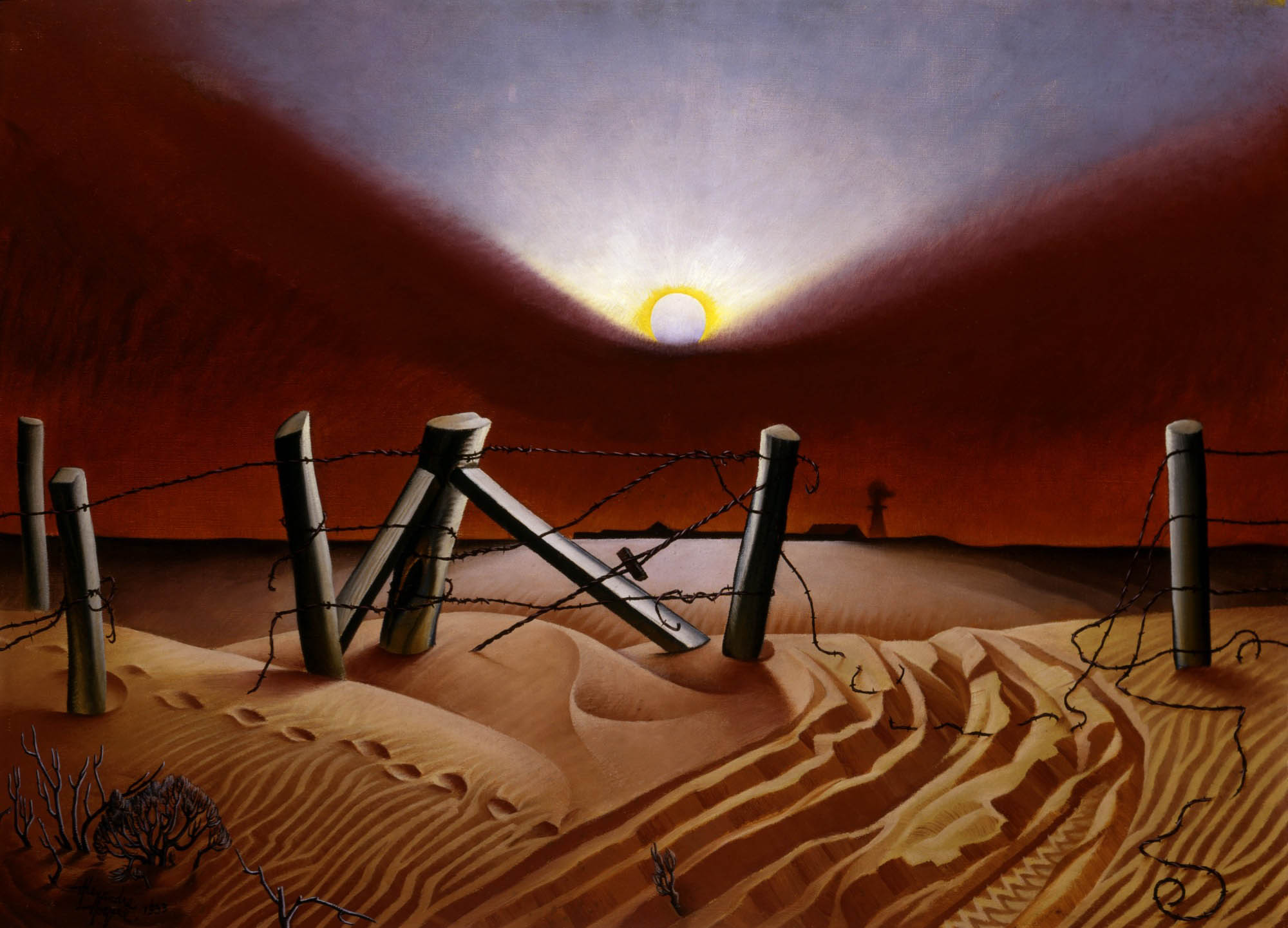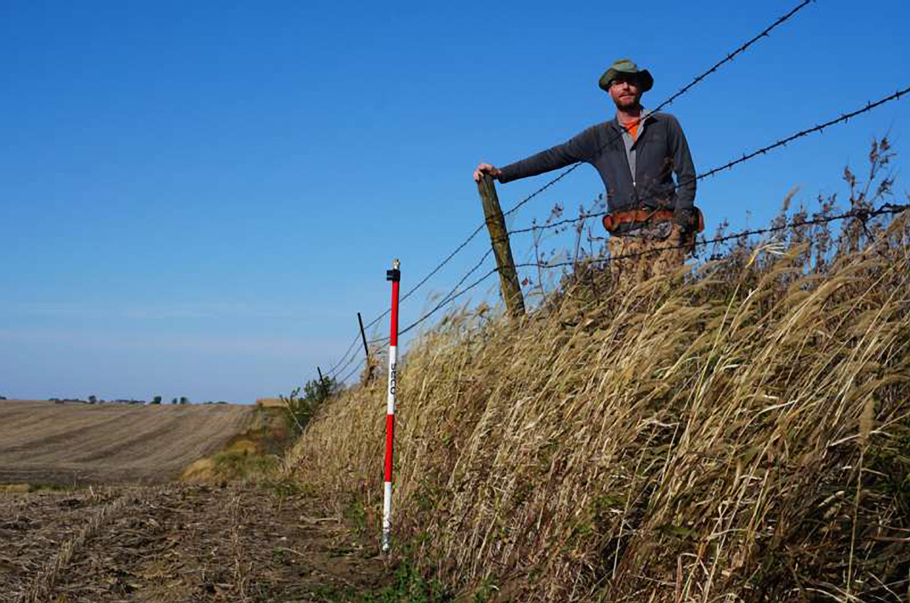
Keep Your Soil in Place (and Precious Water, Too)
by CRARS staff member Sheryl Karas. M.A.

Alexandre Hogue, Dust Bowl, 1933, oil on canvas, Smithsonian American Art Museum, Gift of International Business Machines Corporation, 1969.123
When we talk about Regenerative Agriculture it is usually in the context of climate change and the great potential this form of agriculture provides in terms of reducing greenhouse gasses and sequestering excess carbon from the atmosphere in the soil. However, an equally important issue is that of soil erosion. Do you remember seeing photographs of billowing black clouds of dirt covering everything in sight and leaving behind destroyed lives and farmland during the Dust Bowl? That was soil erosion as a result of severe drought in the Great Plains. The sun baked the topsoil and the wind blew it away. In some areas 75% of the topsoil was lost and the land underneath was too depleted of nutrients to grow healthy crops.
Most of us assume that we learned our lesson and solved that problem long ago. After all, didn’t the federal government fund major programs to institute soil conservation practices all across the country?
They did. Franklin D. Roosevelt made soil and water conservation a priority in his New Deal legislation. The Soil Erosion Service (now the Natural Resources Conservation Service) was established in 1933, and Conservation Districts were created across the country to assist farmers in learning new practices appropriate to the conditions in their individual regions. Farmers were paid to replant prairie grasses. Windbreaks of trees were planted along the edges of farms, and farmers were taught to use a variety of conservation practices like strip cropping (which leaves plant residue on the soil), crop rotations and fallow periods where the land could rest and recover between planting seasons.

Researcher Isaac Larsen standing on the erosional escarpment at Stinton Prairie, Iowa. Credit: UMass Amherst
That, and the return of rain, stopped the worst of the Dust Bowl. However, 89 years later, much of the land has never actually regenerated. Instead, modern irrigation methods keep the soil from blowing away and synthetic fertilizer is used to grow crops despite biological soil fertility depletion. And that soil continues to erode away. A recent study(opens in new window) by the University of Massachusetts, Amherst shows that soil erosion on agricultural land in the Midwest appears to be proceeding at a rate of about two millimeters of soil per year. That’s almost double what the U.S. Department of Agriculture considers sustainable. Agricultural land is actually several feet lower than parts of the prairie that have never been tilled (such as churchyards or nature reserves). The difference is plain to see at escarpments, the drop-off points between tilled land and natural prairie.
It might not seem like this is a big deal. Why can’t we just continue to irrigate and use fertilizer? Unfortunately, now with climate change-fueled droughts becoming more common, some areas of the country are starting to see the underground aquifers they tap for irrigation be depleted. In Southwest Kansas, the water table has dropped(opens in new window) more than 35 feet since 1996. In some places in Kansas, Oklahoma and Texas, the drop is more than 150 feet. The U.S. Department of Agriculture(opens in new window) warns that if this rate of depletion continues, the Ogallala Aquifer that 30% of the nation’s agricultural production depends on could be completely exhausted. And the situation is not much better(opens in new window) in the Central Valley of California—a region responsible for a quarter of the county’s agricultural production and 40% of its fruit, nuts, and other food for human consumption.
Should we all pray for rain? Perhaps. But climate change causes extreme rain events as well as extreme drought. When large quantities of rain fall all at once, that water also causes soil erosion unless steps are taken to prevent that from happening. Fortunately, that is a role regenerative agriculture can play.
How Regenerative Agriculture Stops Soil Erosion and Builds the Soil Back Up
Modern agricultural practices break up soil structure and remove soil organic matter through tillage and often leave large swaths of land bare between growing seasons. Without crop coverage and living roots in the soil, the soil is vulnerable to heat, wind and rain and can easily wash or blow away. But regenerative agriculture takes the opposite approach. Tillage is discouraged and every effort is made to keep a permanent ground cover. If that cover are crops that can fix nutrients back into the ground, so much the better. And if the crop residue is left on the ground as a mulch or made into compost, organic matter in the soil improves even more. The water holding capacity of the soil improves. And because the soil surface is no longer allowed to be bare to the sun and baked into a hardpan, water infiltration improves as well. At the same time, plants and mulch keep the soil from being damaged by excessive rain and holds the soil in place.
Farmers who have adopted these measures to cope with low rainfall say it is saving their farms. For example, Scientific American(opens in new window) reported on the water depletion dilemma in Kansas and interviewed Rodger Funk, a farmer who stopped pumping much water from his well and turned to leaving his crop residue on the ground and planting directly in that instead. That technique alone significantly reduces soil erosion, and it can reduce moisture loss by at least 1 inch and up to 3.5 inches(opens in new window) a year.
Adding no-till practices and/or cover crops, however, can be dramatically more effective. A 2021 study from the University of Illinois(opens in new window) showed that completely shifting to no-till could reduce soil erosion by 72% or more. In the most vulnerable areas, reducing tillage by only 40% was almost equally effective. Another study from 2015(opens in new window) showed that cover crops could reduce soil loss from run-off by up to 80%.
The biggest surprise in using multiple regenerative techniques, however, can occur over time. It was previously thought that soil could not be created except through the geologic process of rocks breaking down over hundreds of years. But when practices that kill the soil biology are eliminated (such as tillage and the use of synthetic fertilizers, herbicides and pesticides), and practices that increase soil organic matter are added (for instance, the use of compost or mulch), earthworms return, soil fungi and other microbes return, and natural processes between plants and the soil biology allow the topsoil to be regenerated. Regenerative farmers often point to topsoil increases with exclamation marks.
Greg Massa of Massa Organics(opens in new window) says, “A few months ago we had a sprinkler line break and we had to dig a pit that was six feet deep to get to this broken water line. And there is now a very clear 20” of very dark topsoil with roots everywhere and a lot of stuff going on. And we built that! I think that’s huge because that was not there before. We built that over the last 15 years!”
Roland Bunch PhD(opens in new window) does consultation in sustainable agricultural development for over 40 NGOs and governments in 50 nations, Bunch’s work takes him to some of the most poverty-stricken areas in the world where, in some cases, the land has become so degraded that adding fertilizer is no longer a cost-effective option. Bunch teaches the smallholder farm owners in these hot, mostly topical regions to use zero or low tillage, intercropping, green manure (mulch from crop residue that composts in place and eventually feeds the soil), and cover crops. He says, “They say it takes 100 years to create an inch of topsoil. But that’s starting out with rocks and letting nature do it. We can do a little better than that. In fact, we can do a whole lot better than that. We can multiply that process by 50 times, making a half inch of topsoil in a year—topsoil that is rich in soil organic carbon that came from atmospheric CO2.”
Soil erosion and depletion has become a serious problem all around the world. According to a study by the European Commission Joint Research Centre in 2017,(opens in new window) we have been losing almost 36 billion tons of soil a year globally. The U.N. has been sounding the alarm since 2015, saying at that time that 1/3 of the earth’s soil had already been degraded and made dire predictions that if then current rates of degradation continued, all of the world’s topsoil could be gone within 60 years. That may have been hyperbole, but it effectively brought attention to a situation that is already contributing to famine in vulnerable areas and lower crop yields (and lower profits) right here in the United States.
The good news is that we have studies and experience that show that by using simple regenerative practices we could rebuild the topsoil that has blown or washed away. Those very same practices remove greenhouse gas carbon from the atmosphere of our overheating planet through photosynthesis and store it in the soil at the same time. Finally, when that carbon is kept in the soil, it helps to feed our crops without the need for excessive, expensive, and water-polluting fertilizers.
Imagine what that could do.
Learn more at the Center for Regenerative Agriculture and Resilient Systems(opens in new window) at Chico State.
